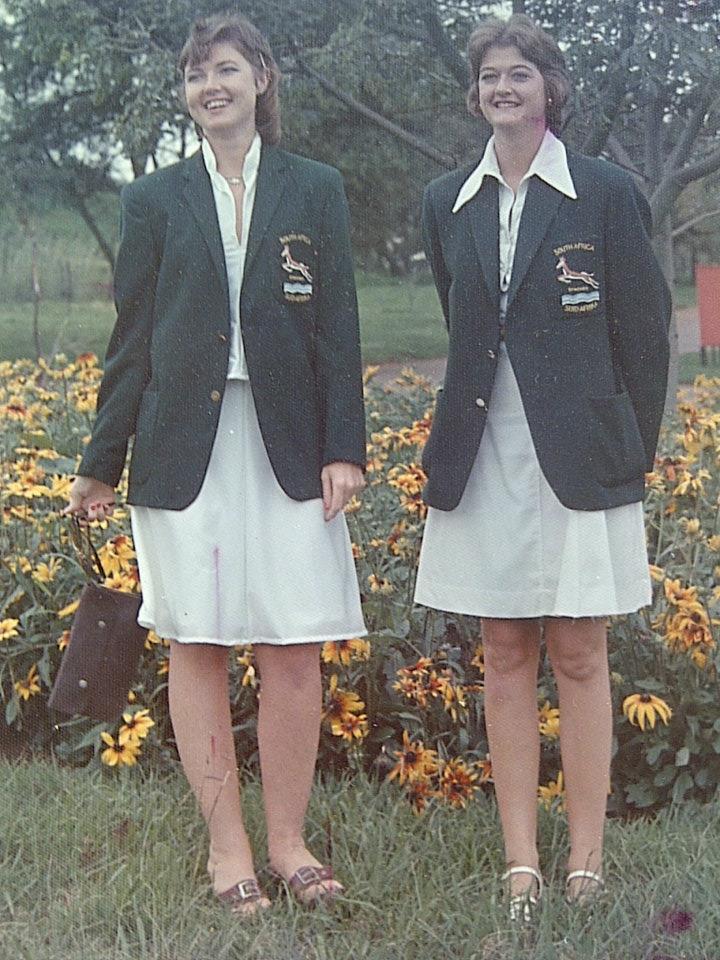South AfricanAmateur Swimming Union
South African Amateur Swimming Association
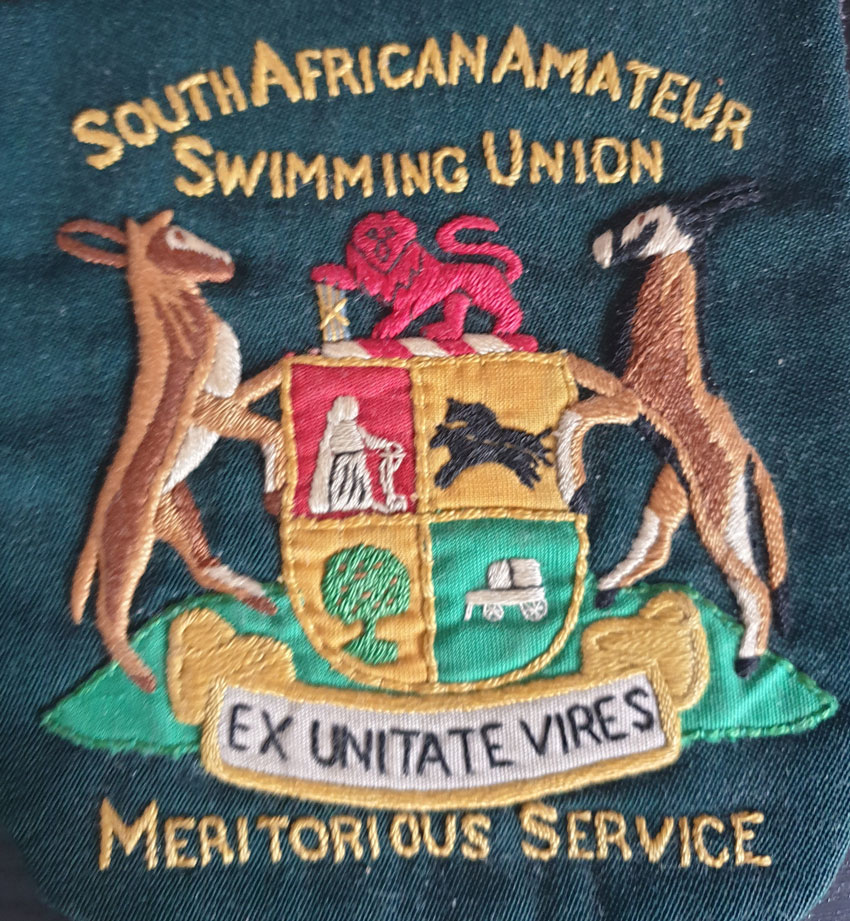
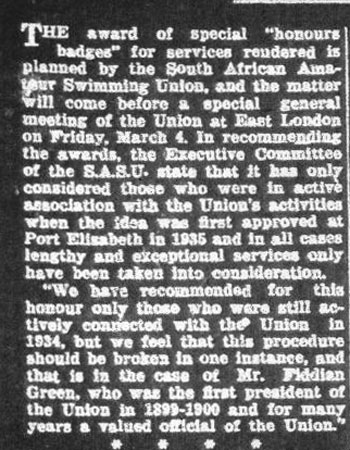
EP Herald - 15 February 1938
Inter-provincial aquatic sports in South Africa - swimming, diving, water polo and synchronised swimming - in South Africa were managed on a provincial basis, by the national governing body known as the South African Amateur Swimming Union (SAASU) since 1899.
Western Province ASA and Eastern Province ASA were the only affiliated Provinces of the SAASU at the first national water polo championship event held at Port Elizabeth in 1900.
After the Boer War ended in 1902, more provinces joined SAASU, until twelve provinces were competing at the 1980 South African Aquatic Championships held in Cape Town. That year, Rhodesia became Zimbabwe, and it no longer affiliated with the SAASU. South West Africa left in 1990 when it became Namibia, and by 1995, the new government of South Africa had scrapped the old provinces in the country.
Later provincial associations were the Orange River Colony (ORC), Transvaal, which later split into Northern and Southern Transvaal, with Eastern and Western Transvaal emerging later. Natal ASA joined in 1905. Mossel Bay and East London initially sent teams to the championships, until they later became part of Eastern Province and Border ASA, respectively. The northern Cape city of Kimberley became the home of the Griqualand West province. The Vaal Triangle province was created in the 1970s.
After the demise of the provincial system, the various aquatic sports disciplines no longer combine their national championships, and the competition is now a club-based event. The South African government sets policy and finances sports governance, and the new governing body for aquatic sports is Swimming South Africa. Following government policy, there are now (2025) nine regional governing bodies, just like the old provinces!
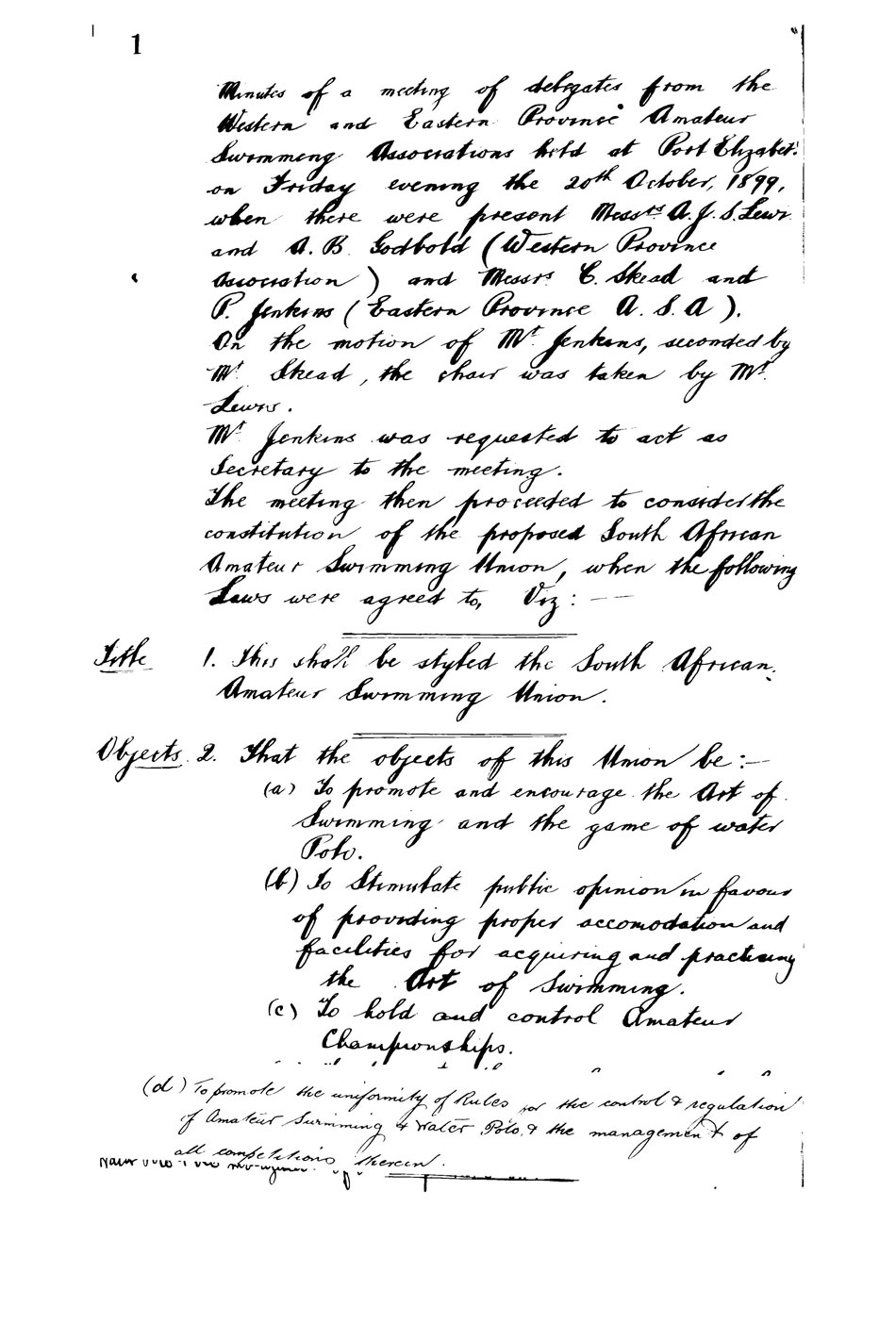
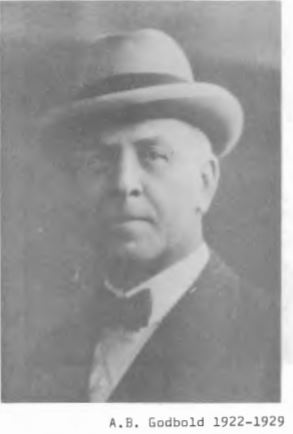
A.B. Godbold - SAASU President 1901 - 1902
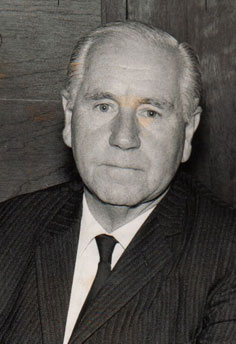
Roy Clegg - SAASU President 1969 - 1976
| SAASU PRESIDENTS |
||
| Year: | Headquarters: | Name: |
| 1900 - 1901 | Port Elizabeth | William Fiddian-Green |
| 1901 - 1902 | Cape Town | A.B. Godbold |
| 1902 - 1903 | Port Elizabeth | A.J. Lewis |
| 1903 - 904 | Cape Town | J.C. Garden |
| 1904 - 1905 | Port Elizabeth | H. Stent |
| 1905 -1906 | Pretoria | Lt. R.H. Watson |
| 1906 -1907 | Durban | J. Ellis Brown |
| 1907-1908 | Port Elizabeth | C.J. Bruce |
| 1908 - 1909 | Cape Town | C.J. Bruce and G. Marais |
| 1909 - 1910 | Johannesburg | G.W.W. Pope |
| 1910- 1911 | Durban | J. Ellis Brown |
| 1911 - 1912 | Port Elizabeth | C.L. Searle |
| 1912 - 1913 | Cape Town | S.G. Serrurier |
| 1913 - 1914 | Johannesburg | S.C. Dowsett |
| 1914 - 1918 | Durban | J. Ellis Brown |
| 1918 - 1920 | Durban | W.H. Hamilton |
| 1920 - 1921 | Port Elizabeth | W.F. Savage |
| 1921 - 1922 | Salisbury | C.D. Clear |
| 1922- 1923 | Cape Town | Dr C. Impey |
| 1923 - 1924 | Johannesburg | F.W. Sarginson |
| 1924 - 1925 | Durban | Gilbert Reynolds |
| 1925 - 1926 | Port Elizabeth | W. Rice |
| 1926 - 1934 | Port Elizabeth | J. McLean |
| 1934 - 1940 | Durban | Gilbert Reynolds |
| 1940 - 1944 | Johannesburg | C.E. Harris |
| 1944 - 1945 | Johannesburg | Rufe Smith |
| 1945 - 1949 | Johannesburg | C.E.Harris |
| 1949 - 1954 | Cape Town | P. Herbstein |
| 1954 - 1959 | Johannesburg | A.R. Taylor |
| 1959 - 1967 | Durban | Neville C. Gracy |
| 1967 - 1969 | Cape Town | Harry Getz |
| 1969 - 1976 | Cape Town | Roy Glegg |
| 1976 - 1992 | Boksburg | Issy Kramer |
| MERITORIOUS SERVICE AWARDS | |
| William FIDDIAN-GREEN | 1960 - R.FOSTER |
| W.A.COPELAND | Lou SAVAGE |
| Gilbert REYNOLDS | F. LEEMANS |
| S.C. DOWSETT | B.OXFORD |
| W. RICE | J.KIPLING |
| J. McLEAN | R. PANNALL |
| R. WARD | |
| G.E. GODFREY | 1961 - L. BUNING |
| C. NELSON | |
| Max THIEL | 1962 - G.GLENCROSS |
| J. BOSANQUET | N. SULLIVAN |
| Rufe SMITH | H.F.W. BASFORD |
| H.C. VARLEY | |
| Alex BULLEY (1935) | 1964 - Neville GRACIE |
| Rachael FINLAYSON (MRS) | C.B. BRADLEY |
| C.E. HARRIS (1947) | AJ. McLACHLAN |
| E.O. WEGNER (1947) | Vic MYBURGH |
| A.R. TAYLOR (1947) | H. HAMMOND |
| P. HERBSTEIN (1947) | |
| J.J. GLENDINN1NG (1947) | 1967 - E.M. Doods BULLEY (MRS) |
| A.V. NUNN | Issy KRAMER |
| Harry GETZ (1947) | A.E. LIEVESLEY |
| D. NATHAN | E.J. ALLEN |
| S.COLLINS (1947) | |
| S.T. COCKHEAD (1955) | 1968 - F.J.HARD1NG |
| I. LAZAROW (1957) | |
| G. INGE (1957) | 1970 - N.H. LIEVESLEY (MRS) |
| H.B. BLAKE | D. GLEGG (MRS) |
| G.H. V.D. BERG (1957) | R.W. GRANT-STUART |
| H. RAKIN | P.S.B. KRIGE |
| E.C. MORETON | |
| R. HONIKMANN | 1971 - T.F.W. BASSETT |
| Roy GLEGG | J.A.R. SMIT |
| M. HACK | Jack CURRIE |
| E.B. SHEPHERD | J.A. COULL |
| H.H. FOWLER | |
| S.G. HOLMES (1947) | (probably incomplete) |
| F.C.CLAMPETT (1947) |
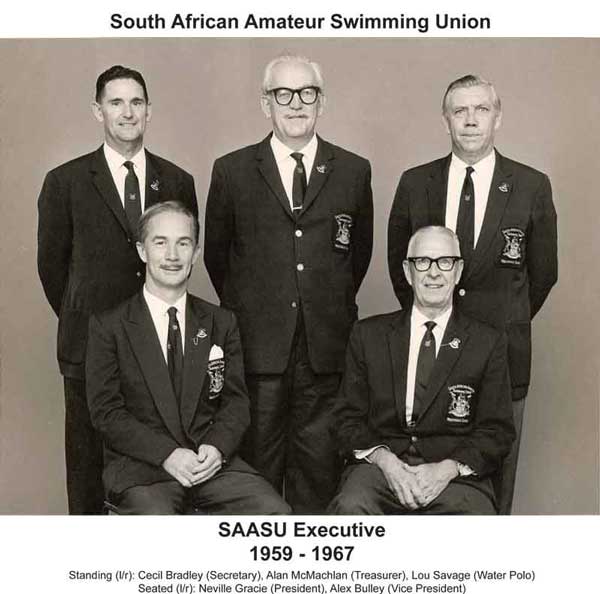
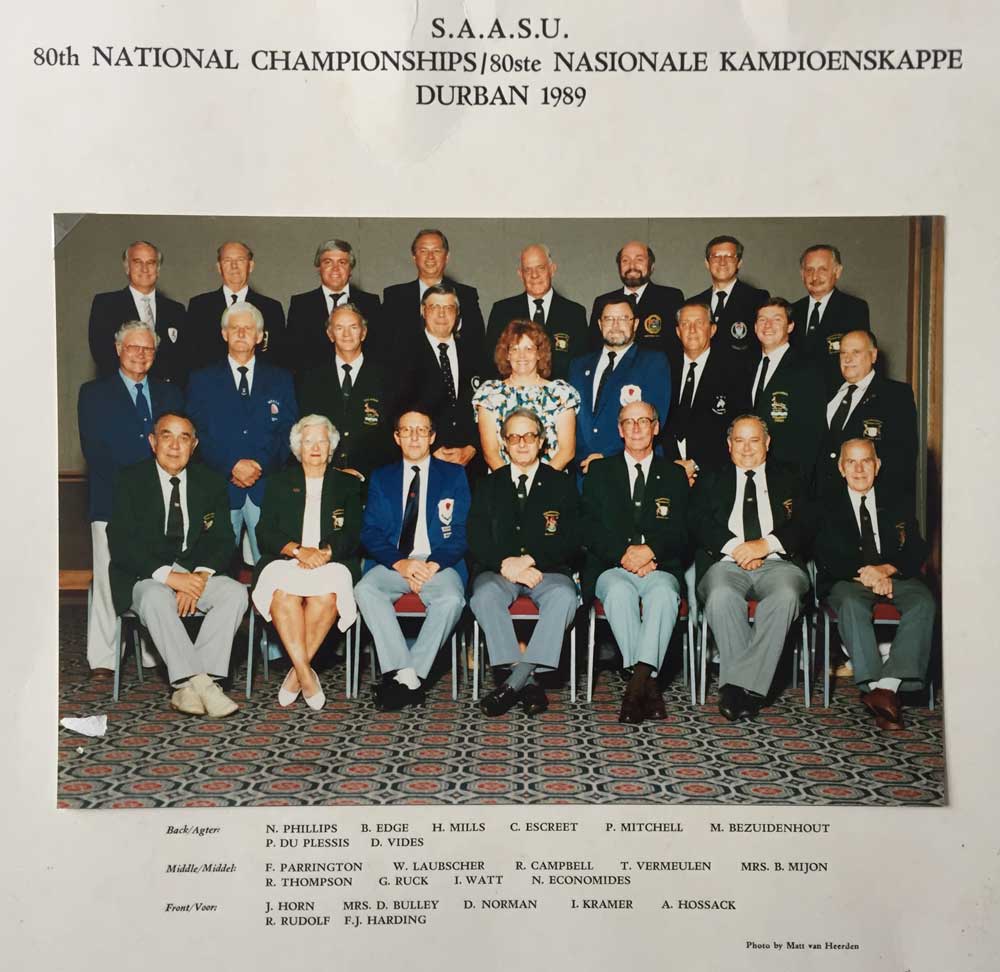
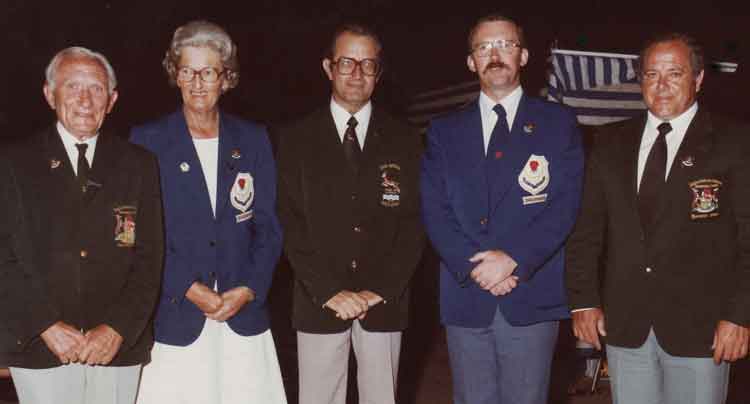
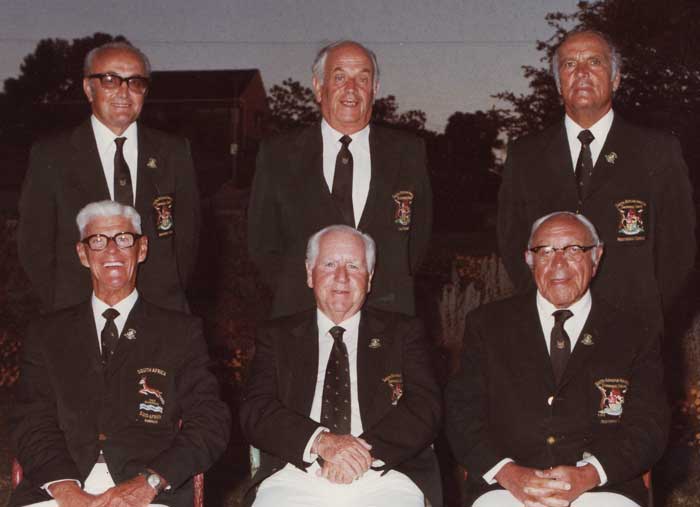
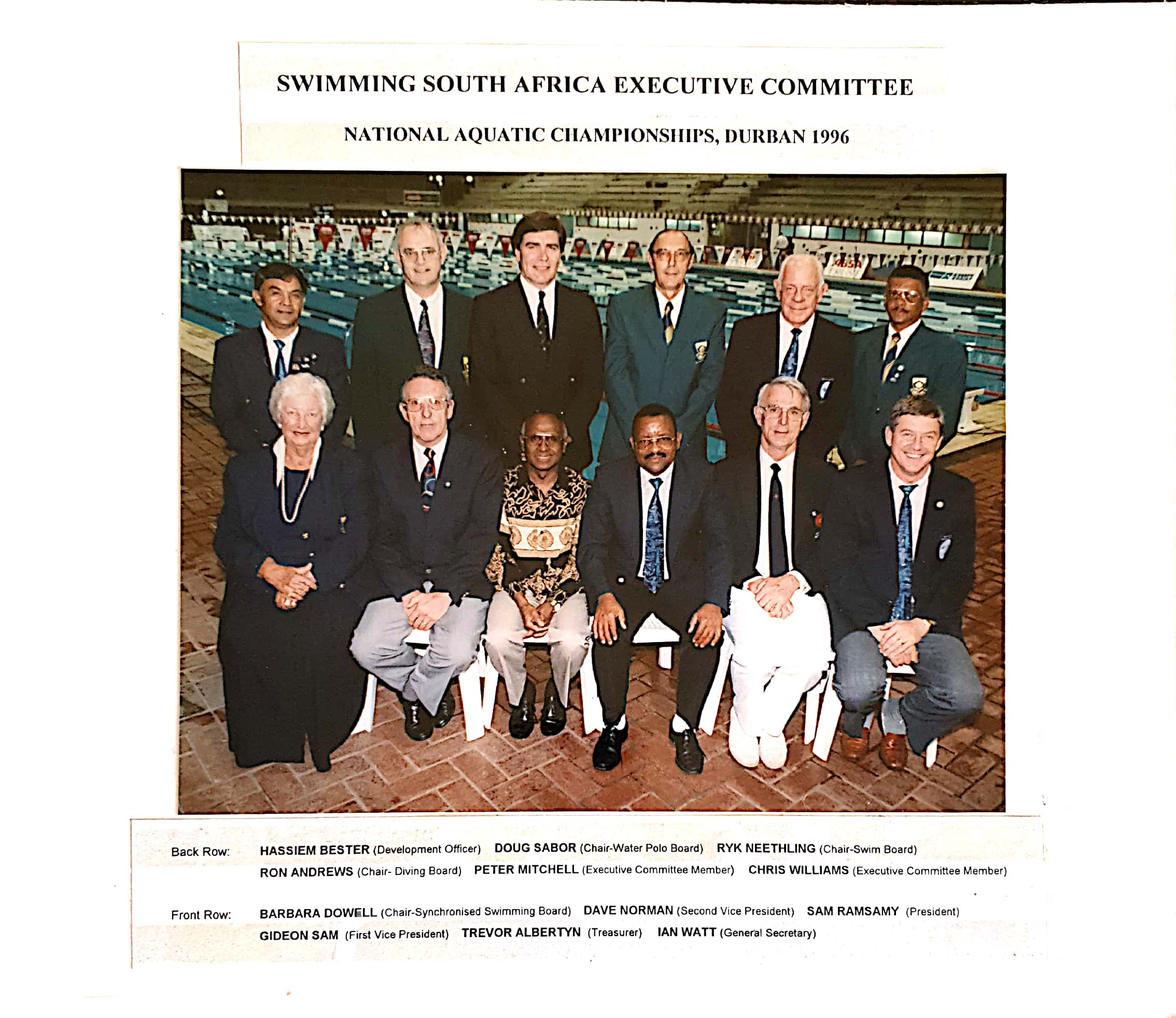
Provinces of South African Aquatic Sports

Eastern Province

Western Province

Natal

Transvaal

Northern Transvaal

Eastern Transvaal

Western Transvaal

Orange Free State

Griqualand West

Rhodesia

Border

South West Africa

Vaal Triangle
The history of SAASU was largely the story of the competing provinces. The competitors, officials, coaches, facilities, clubs, schools, and competitions all identified with their province. At nationals, they vied to win the Ellis Brown Aggregate Trophy, which was awarded to the province with the overall highest number of points in all four disciplines combined. Rhodesia dominated South African aquatics during the 60s, winning the Ellis Brown Trophy 7 years in a row!
By 1999, the old provinces had been abolished, and press reports no longer mention the trophy winners.
- Hits: 644



